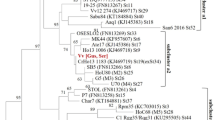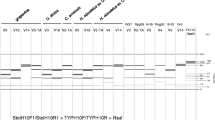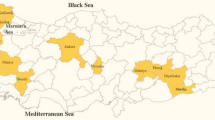Abstract
The most important Grapevine Yellows (GY) phytoplasma diseases in Europe are Flavescence dorée (FD) and Bois noir (BN); they are spread in vineyard by two proven vectors, Scaphoideus titanus Ball and Hyalesthes obsoletus Signoret, respectively. Other potential vectors of GY have been identified, which are thought to play a secondary role. The GY control strategies are not always effective and an in-depth study on the ecological cycle of the pathogens at regional scale would be of paramount importance. This study was carried out in 48 representative sites of wine-growing area South of Swiss Alps, with the aim to identify known and potential vectors and to characterize the FD and BN phytoplasmas isolates. Out of 167 Auchenorrhyncha species recorded, 27 were known or potential vectors of phytoplasmas and five of those tested positive for phytoplasmas. S. titanus was infected by 16SrV-D subgroup phytoplasma and no clear relationship between its population density and disease outbreaks was observed. Orientus ishidae harboured 16SrV-C and 16SrV-D subgroups suggesting its potential role in spreading 16SrV-C phytoplasma isolates from arboreal plants to grapevine and FD-D from grapevine to grapevine. H. obsoletus was infected by BN phytoplasmas, tuf-types a and b, however it was collected with relatively low abundance. Reptalus panzeri and R. cuspidatus tested positive to tuf-type b, but only R. cuspidatus was common and abundant in the investigated vineyards. To define the range of alternative vectors using a detailed approach on regional scale provides background information to get a more clear vision on the spreading of phytoplasmas in the vineyards.


Similar content being viewed by others
References
Angelini, E., Clair, D., Borgo, M., Bertaccini, A., & Boudon-Padieu, E. (2001). Flavescence dorée in France and Italy - occurrence of closely related phytoplasma isolates and their near relationships to Palatinate grapevine yellows and an alder yellows phytoplasma. Vitis, 40(2), 79–86.
Angelini, E., Luca Bianchi, G., Filippin, L., Morassutti, C., & Borgo, M. (2007). A new TaqMan method for the identification of phytoplasmas associated with grapevine yellows by real-time PCR assay. Journal of Microbiological Methods, 68(3), 613–622. doi:10.1016/j.mimet.2006.11.015.
Aryan, A., Brader, G., Mortel, J., Pastar, M., & Riedle-Bauer, M. (2014). An abundant ‘Candidatus Phytoplasma solani’ tuf b strain is associated with grapevine, stinging nettle and Hyalesthes obsoletus. European Journal of Plant Pathology, 140(2), 213–227. doi:10.1007/s10658-014-0455-0.
Atanasova, B., Jakovljević, M., Spasov, D., Jović, J., Mitrović, M., Toševski, I., & Cvrković, T. (2015). The molecular epidemiology of bois noir grapevine yellows caused by ‘Candidatus Phytoplasma solani’ in the Republic of Macedonia. European Journal of Plant Pathology, 142(4), 759–770. doi:10.1007/s10658-015-0649-0.
Batlle, A., Altabella, N., Sabate, J., & Laviña, A. (2008). Study of the transmission of stolbur phytoplasma to different crop species, by Macrosteles quadripunctulatus. Annals of Applied Biology, 152, 235–242.
Bosco, D., Alma, A., & Arzone, A. (1997). Studies on population dynamics and spatial distribution of leafhoppers in vineyards (Homoptera: Cicadellidae). Annals of Applied Biology, 130(1), 1–11. doi:10.1111/j.1744-7348.1997.tb05778.x.
Credi, R., Terlizzi, F., Milanesi, L., Bondavalli, R., Cavallini, G., Montermini, A., et al. (2006). Wild host plants of stolbur phytoplasma and its vector, Hyalesthes obsoletus, at sites of grapevine Bois noir occurrence in Emilia-Romagna, Italy. 15th Meeting ICVG, Stellenbosch, SouthAfrica, 182–183.
Cvrković, T., Jović, J., Mitrović, M., Krstić, O., & Toševski, I. (2014). Experimental and molecular evidence of Reptalus panzeri as a natural vector of bois noir. Plant Pathology, 63(1), 42–53. doi:10.1111/ppa.12080.
Della Giustina, W. (1989). Homoptères Cicadellidae 3: compléments. Faune de France, 73, 1–350.
EPPO (2007). Grapevine flavescence dorée phytoplasma. EPPO Bulletin, 37(3), 536–542. doi:10.1111/j.1365-2338.2007.01161.x.
Filippin, L., Jović, J., Cvrković, T., Forte, V., Clair, D., Toševski, I., et al. (2009). Molecular characteristics of phytoplasmas associated with Flavescence dorée in clematis and grapevine and preliminary results on the role of Dictyophara europaea as a vector. Plant Pathology, 58(5), 826–837. doi:10.1111/j.1365-3059.2009.02092.x.
Franova, J., Navratil, M., & Jakesova, H. (2009). Molecular identification of stolbur phytoplasma associated with red clover dwarf disease symptoms. Journal of Phytopathology, 157, 52–56.
Gaffuri, F., Sacchi, S., & Cavagna, B. (2011). First detection of the mosaic leafhopper, Orientus ishidae, in northern Italian vineyards infected by the flavescence dorée phytoplasma. New Disease Reports, 24, 22. doi:10.5197/j.2044-0588.2011.024.02210.1094/Phyto-84-55910.5197/j.2044-0588.2010.022.011.
Gatineau, F., Larrue, J., Clair, D., Lorton, F., Richard-Molard, M., & Boudon-Padieu, E. (2001). A new natural planthopper vector of stolbur phytoplasma in the genus Pentastiridius (Hemiptera: Cixiidae). European Journal of Plant Pathology, 107, 263–271.
Gotelli, N. J., & Colwell, R. K. (2001). Quantifying biodiversity: procedures and pitfalls in the measurement and comparison of species richness. Ecology Letters, 4(4), 379–391. doi:10.1046/j.1461-0248.2001.00230.x.
Günthart, H., & Mühlethaler, R. (2002). Provisorische Checklist der Zikaden der Schweiz (Insecta: Hemiptera, Auchenorrhyncha). Denisia, 176, 329–338.
Hamilton, K.G.A. (1985). Leafhoppers of ornamental and fruit trees in Canada. Agriculture Canada Publication, 1779E/F: 1–71.
Holzinger, W. E., Kammerlander, I., & Nickel, H. (2003). Fulgoromorpha, Cicadomorpha excl. Cicadellidae (Vol. Bd. 1). Leiden: Leiden: Brill.
Imo, M., Maixner, M., & Johannesen, J. (2013). Sympatric diversification vs. immigration: deciphering host-plant specialization in a polyphagous insect, the stolbur phytoplasma vector Hyalesthes obsoletus (Cixiidae). Molecular Ecology, 22(8), 2188–2203. doi:10.1111/mec.12237.
IRPCM, Phytoplasma/Spiroplasma Working Team-PhytoplasmaTaxonomy Group (2004). ‘Candidatus Phytoplasma’, a taxon for wall-less, non-helical prokaryotes that colonize plant phloem and insects. International Journal of Systematic and Evolutionary Microbiology, 54, 1243–1255.
Jermini, M., Schaerer, S., Johnston, H., Colombi, L., & Marazzi, C. (2014). Dix ans de flavescence dorée au Tessin. Revue Suisse de viticulture arboriculture horticulture, 46(4), 222–229.
Johannesen, J., Lux, B., Michel, K., Seitz, A., & Maixner, M. (2008). Invasion biology and host specificity of the grapevine yellows disease vector Hyalesthes obsoletus in Europe. Entomologia Experimentalis et Applicata, 126(3), 217–227. doi:10.1111/j.1570-7458.2007.00655.x.
Jović, J., Cvrković, T., Mitrović, M., Krnjanjić, S., Petrović, A., Redinbaugh, M. G., et al. (2007). Maize redness in Serbia caused by stolbur phytoplasma is transmitted by. Reptalus panzeri. Bulletin of Insectology, 60(2), 397–398.
Kehrli, P., & Delabays, N. (2012). Controlling ‘bois noir’ disease on grapevine: does the timing of herbicide application affect vector emergence? Journal of Applied Entomology, 136(3), 234–237. doi:10.1111/j.1439-0418.2011.01635.x.
Kessler, S., Schaerer, S., Delabays, N., Turlings, T. C. J., Trivellone, V., & Kehrli, P. (2011). Host plant preferences of Hyalesthes obsoletus, the vector of the grapevine yellows disease ‘bois noir’, in Switzerland. Entomologia Experimentalis et Applicata, 139(1), 60–67. doi:10.1111/j.1570-7458.2011.01107.x.
Kunz, G., Roschatt, C., & Schweigkofler, W. (2010). Biodiversity of panthoppers (Auchenorrhyncha) in vineyards infected by Bois noir phytoplasma. Gredleriana, 10, 89–108.
Landi, L., Isidoro, N., & Riolo, P. (2013). Natural Phytoplasma Infection of Four Phloem-Feeding Auchenorrhyncha Across Vineyard Agroecosystems in Central-Eastern Italy. Journal of Economic Entomology, 106(2), 604–613. doi:10.1603/ec12400.
Langer, M., & Maixner, M. (2004). Molecular characterisation of grapevine yellows associated phytoplasmas of the stolbur-group based on RFLP-analysis of non-ribosomal DNA. Vitis, 43(4), 191–199.
Lee, I. M., Martini, M., Marcone, C., & Zhu, S. F. (2004). Classification of phytoplasma strains in the elm yellows group (16SrV) and proposal of ‘Candidatus Phytoplasma ulmi’ for the phytoplasma associated with elm yellows. International Journal of Systematic and Evolutionary Microbiology, 54(2), 337–347. doi:10.1099/ijs.0.02697-0.
Maixner, M. (1994). Transmission of German grapevine yellows (Vergilbungskrankheit) by the planthopper Hyalesthes obsoletus (Auchenorrhyncha: Cixiidae). Vitis, 33, 103–104.
Maixner, M., & Reinert, W. (1999). Oncopsis alni (Schrank) (Auchenorrhyncha: Cicadellidae) as a vector of the alder yellows phytoplasma of Alnus glutinosa (L.) Gaertn. European Journal of Plant Pathology, 105, 87–94.
Maixner, M., Reinert, W., & Darimont, H. (2000). Transmission of grapevine yellows by Oncopsis alni (Schrank) (Auchenorryncha: Macropsinae). Vitis, 39(2), 83–84.
Maniyar, B., Kehrli, P., & Johannesen, J. (2013). Population structure and incidence of the stolbur phytoplasma vector Hyalesthes obsoletus (Cixiidae) among geographic regions in Switzerland. [Article]. Journal of Applied Entomology, 137(8), 589–600. doi:10.1111/jen.12034.
Marcone, C. (2014). Molecular biology and pathogenicity of phytoplasmas. Annals of Applied Biology, 165(2), 199–221. doi:10.1111/aab.12151.
Martini, M., Botti, S., Marcone, C., Marzachì, C., Casati, P., Bianco, P. A., et al. (2002). Genetic variability among Flavescence dorée phytoplasmas from different origins in Italy and France. Molecular and Cellular Probes, 16, 197–208.
Mehle, N., Seljak, G., Rupar, M., Ravnikar, M., & Dermastia, M. (2010). The first detection of a phytoplasma from the 16SrV (Elm yellows) group in the mosaic leafhopper Orientus ishidae. New Disease Reports, 22, 11. doi:10.5197/j.2044-0588.2010.022.01110.1111/j.1365-3059.2009.02092.x10.1111/j.1365-3059.2007.01688.x.
Mikec, I., Križanac, I., Budinščak, Z., Šeruga Musić, M., Krajačić, M., & Škorić, D. (2006) Phytoplasmas and their potential vectors in vineyards of indigenous Croatian varietis. In Meeting of the International Council for the Study of Virus and Virus-like Diseases of the Grapevine (ICVG), Stellenbosch (South Africa), (pp. 255–257)
Nickel, H. (2003). The Leafhoppers and Planthoppers of Germany (Hemiptera Auchenorrhyncha): Patterns and strategies in a highly diverse group of phytophageous insects: Copublished by Pensoft Publishers. Keltern: Sofia-Moscow and Goecke & Evers.
Palermo, S., Elekes, M., Botti, S., Ember, I., Alma, A., Orosz, A., et al. (2004). Presence of stolbur phytoplasma in Cixiidae in Hungarian Vineyards. Vitis, 43, 201–203.
Picciau, L., Lessio, F., & Alma, A. (2008). Preliminary data on the Cixiid fauna of the vineyard agro-ecosystem in Piedmont (North-Western Italy). Bulletin of Insectology, 61(1), 197–198.
Pinzauti, F., Trivellone, V., & Bagnoli, B. (2008). Ability of Reptalus quinquecostatus (Hemiptera: Cixiidae) to inoculate stolbur phytoplasma to artificial feeding medium. Annals of Applied Biology, 153, 299–305.
Ribaut, H. (1936). Homoptères Auchènorhynches 1. (Typhlocybidae). Faune de France, 31, 1–228.
Riedle-Bauer, M., Sára, A., & Regner, F. (2008). Transmission of a Stolbur Phytoplasma by the Agalliinae LeafhopperAnaceratagallia ribauti(Hemiptera, Auchenorrhyncha, Cicadellidae). Journal of Phytopathology, 156(11–12), 687–690. doi:10.1111/j.1439-0434.2008.01416.x.
Schaerer, S., Johnston, H., Gugerli, P., Linder, C., Schaub, L., & Colombi, L. (2007). Flavescence doree in Switzerland: spread of the disease in canton of Ticino and of its insect vector, now also in cantons of Vaud and Geneva. Bulletin of Insectology, 60(2), 375–376.
Schmid, A., & Emery, S. (2001). La maladie du Bois noir dans le vignoble valaisan. IOBC/wprs Bulletin, 24, 287–289.
Schneider, B., Gibb, K. S., & Seemuller, E. (1997). Sequence and RFLP analysis of the elongation factor tu gene in differentation and classification of phytoplasmas. Microbiology, 143, 3381–3389.
Schvester, D., Carle, P., & Moutous, G. (1963). Transmission de la flavescence dorée de la vigne par Scaphoideus littoralis Ball. Annales des Epiphyties, 14, 175–198.
Sforza, R., Clair, D., Daire, X., Larrue, J., & Boudon-Padieu, E. (1998). The role of Hyalesthes obsoletus (Hemiptera: Cixiidae) in the occurrence of bois noir of grapevines in France. Journal of Phytopathology, 146(11–12), 549–556.
Trivellone, V., Schoenenberger, N., Jermini, M., de Bello, F., Mitchell, E. A. D., & Moretti, M. (2014). Indicators for taxonomic and functional aspects of biodiversity in the vineyard agroecosystem of Southern Switzerland. Biological Conservation, 170, 103–109.
Acknowledgments
We thank Santiago Schaerer (ACW, Changins, Switzerland) for his help with the DNA extraction and to provide further four positive insect samples. We thank also Mauro Jermini (ACW, Cadenazzo, Switzerland) for useful discussions. Financial support for identification of Auchenorrhyncha was provided by the Dipartimento dell’Educazione della Cultura e dello Sport (DECS) of Ticino Canton.
Author information
Authors and Affiliations
Corresponding author
Ethics declarations
Conflict of interest
The authors declare that this work complies to the Ethical Standards of the journal, and that they have no conflict of interest.
Rights and permissions
About this article
Cite this article
Trivellone, V., Filippin, L., Narduzzi-Wicht, B. et al. A regional-scale survey to define the known and potential vectors of grapevine yellow phytoplasmas in vineyards South of Swiss Alps. Eur J Plant Pathol 145, 915–927 (2016). https://doi.org/10.1007/s10658-016-0880-3
Accepted:
Published:
Issue Date:
DOI: https://doi.org/10.1007/s10658-016-0880-3




